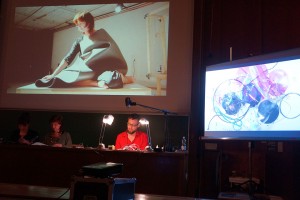23 – 27 September 2014
Body Diagrams: On the Epistemic Kinetics of Gesture,
University of Tübingen, Germany
convened by Alexander Gerner and Irene Mittelberg @ the 14th international Congress of the German Society of Semiotics 2014 ‘Verstehen und Verständigung / Comprehension and Understanding’
For the conference panel Body Diagrams: On the Epistemic Kinetics of Gesture, we – Nikolaus Gansterer, Mariella Greil and Emma Cocker – presented a performance-lecture based on the first year of our research project Choreo-graphic Figures: Deviations from the Line. We staged findings from our recent ‘Method Lab’ by presenting a series of ‘kinetic diagrams’ or “choreo-graphic figures” (e.g. figure of arrival, figure of touch [approaching the other], figure of ‘becoming comma’) in the form of a hybrid performative lecture involving live performance, drawing and spoken word. Choreo-graphic Figures: Deviations from the Line addresses the materiality of the choreo-graphic and the elasticity of figures, exploring the performativity of notation by developing shared choreo–graphic figures (figures of thought, speech, movement) for making tangible this enquiry. Our research project makes productive the close relation between the German words “Aufzeichungen” (notes) and “Zeichnungen” (drawings), conceiving of the ‘in-between-space’ from draft to articulation as a site of potential for unexpected connections. To explore the performative character of notation, the researchers practice kinetic as well as graphic modes of inscription, expanded tactics extending beyond apparent physical limitations (of the mind, the hand, pencil and paper), integrating time, sound, movement and narration through the embodied practice of choreographic performance. Within our enquiry, we seek modes of inscription between the lines, interested in the interval or gap between seemingly oppositional or irreconcilable terms: choreo + graphic; sign + non-sign, ‘containment’ + ‘contingency’; form + formlessness, movement + materiality, being + becoming … movement becoming sound becoming sign becoming drawing becoming breath becoming physical becoming dot becoming comma becoming a bodily form becoming focused becoming acoustic becoming comfortable becoming certain becoming dispersed again becoming again becoming reverberation becoming material becoming impatient becoming another quality becoming frame becoming unstable becoming a knot becoming ghost becoming both becoming amplified becoming imperceptible becoming expanded becoming tentative becoming attention becoming words becoming rhythm becoming a mark becoming a fold becoming choreo-graphic.
Our conference presentation will be developed through further research findings and reflections generated during 2015, as a book chapter entitled Choreo-graphic Figures: Vitality Gestures & Embodied Diagrammatics for the forthcoming publication Body Diagrams, eds. Alexander Gerner and Irene Mittelberg, (Gesture Series, John Benjamins, Amsterdam, Publication date: 2017 TBC)
About the conference panel: Across various disciplines, the epistemic kinetics of manual gestures and other forms of bodily movement typically employed in everyday discourse as well as more specific contexts of meaning-making and knowledge mediation is becoming more and more recognised … Gesture, posture, and forward movement also assume crucial roles in ascribing meaning to objects and scenes in the visual and performing arts, e.g. design, image, drama, dance, and film. Not limiting gestures to communicative modalities apt to represent objects and actions or to manage social interaction, this conference explores gestures as diagrammatic tools in the dynamic development of human conceptualization and knowledge of the world. Taking into account kinetic, haptic and sensed qualities of meaningful experience and expression, the guiding assumption is that concrete body diagrams do not merely represent and reproduce, but first and foremost bring about, transform and constitute ideas and understanding in action-perception cycles. Bodily practices of interest include manual and full-body gestures of indicating, pointing, placing and positioning, gestures of seizing, capturing, articulating and explicating; gestures of drawing, graphing, underlining, labeling and delimiting; gestures of (re- and dis-)placement and expansion, gestures of opening and resistance of the body, gestures of linking, relation and correlation, merging, grouping and splitting, gestures of schematization, gestures of creation, performance and displaying, that is, gestures that generally instill coherence, understanding, and meaning. While acknowledging the fact that such gestural diagrams may indeed trace relations or constellations already experienced or learned, by relating gesture and diagram, however, our main aim is to explore their creative potential and epistemic functions, that is, ways in which body diagrams may serve to sense, trigger and establish new thoughts, connections and conceptual/semiotic structures.
Conference panel presenters included: Frederik Stjernfelt (Copenhagen); Alexander Gerner (Lisbon); Valeria Giardino (Paris); Christina Krause (Bremen); Irene Mittelberg & Daniel Schüller (Aix-la-Chapelle (Aachen)); Doris Schöps (Berlin); Paola Crespi (London); Nikolaus Gansterer (Vienna), Emma Cocker (Nottingham), Mariella Greil (Vienna).
Programme Link: http://cfcul.fc.ul.pt/calendarihttp://cfcul.fc.ul.pt/calendario/arquivo/docs/conference_programme.pdfo/arquivo/docs/conference_programme.pdf


